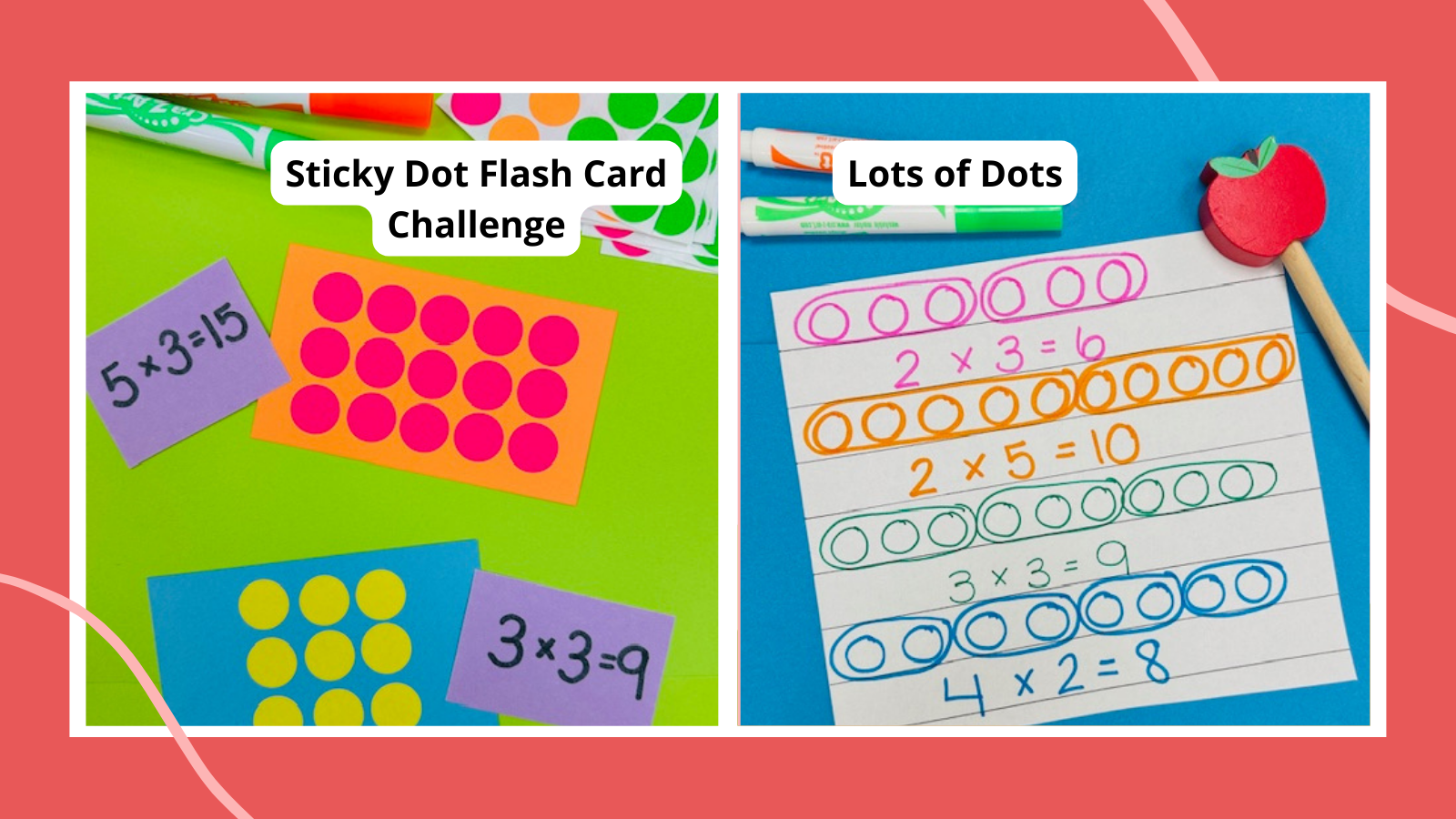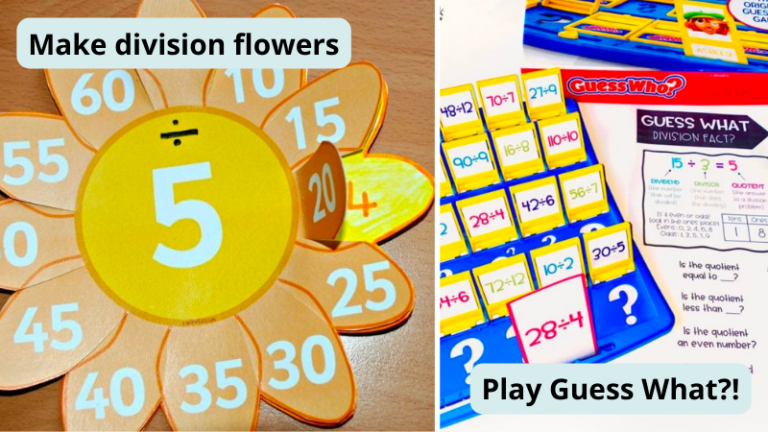A lot of math has to do with answering the same question: “How many?” You can count, you can add, you can skip-count, but one of the most efficient and accurate ways to answer the question is by grouping things together and multiplying. It’s a skill we use every day in real life throughout our lives, and the activities below are a fun way to teach students multiplication.
We help young learners understand how multiplication works by hands-on exploration at first, through pictorial work, and eventually to the most efficient strategy of all: memorization of multiplication facts for easy recall. Here are some great ways to teach multiplication to get your students excited and engaged from the beginning of understanding to multiplication mastery.
Sticky Dot Flash Card Challenge
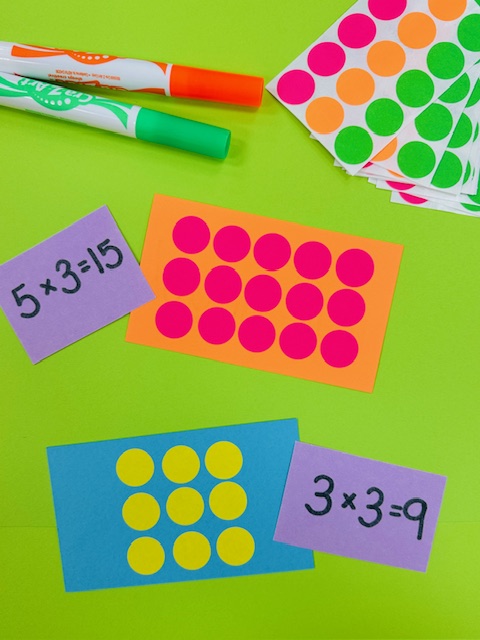
Purchase a few sets of colorful sticky dots. On pieces of card stock or construction paper, arrange sticky dots in arrays that model multiplication facts. For example, to show 3 x 4, make three rows with four dots in each row. Then have students make these on pieces of card stock with the dots on one side and the multiplication fact written on the back. Once students have made a set of at least 12 cards, have them meet with a partner to play a game. The first player flashes a card with dots showing for two seconds. The second player must try to quickly guess the fact and answer. The lead player takes the card out and shows both sides to check the answer. Have students take turns flashing cards and working through the deck.
Human Body Multiplication
Everybody has two ears, but how many ears do three students have all together? Practice multiplication by calling up three students to the front of the classroom. Ask questions for the whole class that focus on multiplying such as, “How many ears does this group have all together (3 x 2 = 6)?” “How many fingers does this group have all together? (3 x 10 = 30)?” “How many noses do they have all together (3 x 1 = 3)?” As you ask, have the rest of the class write the multiplication problem and the product on a whiteboard or paper and share their answers. Give all students a chance to come up and be part of the multiplying group. Change the number of students in the modeling group to change the resulting facts.
Marvelous Multiplying Martians Poem
Supply each student with a set of 20 counters. Then read this poem and sub in two numbers in the blanks as you read. Students use their counters to model the problem and find the answer.
Early in the morning, ___ Martians came. They multiplied by ___ and played a football game. When earthlings saw them playing, the whole crowd shouted, “Wow!” Just how many Martians do you think are playing football now?
Try various numbers and have kids rhyme along with you. You can write the poem on a chart for all to read along.
Clapping Facts
Here’s a good listening and math game. Tell students you will clap out a multiplication fact. They should listen carefully to the number of claps, and write the fact they hear down on a whiteboard or paper. For example, for 2 x 7, you would clap like this:
Clap, clap, clap, clap, clap, clap, clap (pause)
Clap, clap, clap, clap, clap, clap, clap (stop)
For 3 x 3 it would sound like this:
Clap, clap, clap (pause)
Clap, clap, clap (pause)
Clap, clap, clap (stop)
Ask students to share their answers. After you’ve done a few, have students take turns choosing facts and leading the clapping. Write all the facts you’ve done on the board so there won’t be any repeats.
Multiplying Card Game
Using index cards, have each student create a set of digit cards from 0 to 10 with five copies of each digit card in the deck. Then ask students to partner up and put one deck in the middle. The lead player shuffles the deck and then deals two cards to each player. After that, players multiply their two cards and announce their individual products. Whoever has the highest product wins all four cards. The player with the most cards at the finish of the deck wins.
Multiplication Model Make-It
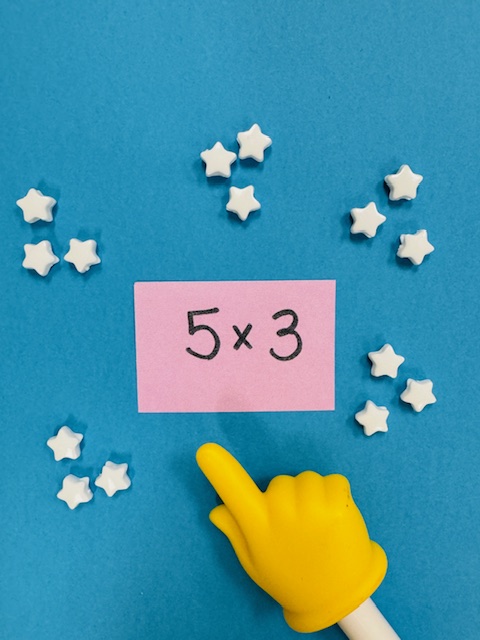
Kids like to get their hands on things and move them around. Keeping learning active is always a great strategy with kids. Here’s a good way to do that and practice multiplication.
Provide each student with a group of small manipulatives such as cubes, counters, beads, or even dried beans (very cheap and they work well!). Then call out a multiplication fact and ask students to group their manipulatives to model the fact. For example, if you call out 5 x 5, students will create five groups of five beans in each. After they complete this task, ask them to announce the product. Students can take turns leading this activity as well.
Calculator Checker
Give students simple calculators. It’s good to give your class practice with how calculators work. Call out two factors, like “3 and 7.” Students input the two factors on the calculator, pushing the x button in between, but they don’t press the = button. Wait 30 seconds while students think about the answer. Then ask for possible answers. After everyone has a chance to respond, tell students to press the = button to check their answers. Let students take turns leading this game.
Multiplication Shake
Ask each student to bring in an empty egg carton. In the bottom of each section of the carton, have them write a number from 0 to 11 with a permanent marker. Give each player two beans or beads. Players put the beads in their boxes and close them tight. When you say go, they shake the box. When you say stop, they open the box and multiply the two numbers where the beads landed. Each player raises their hand and shares the fact they came up with along with the product. You can ask things like, “Who has the highest product?” “Who has the lowest product?” “Who has an odd or even product?” and then try it again.
Hole-Punch Multiplier
Arrays are a great way for students to “see,” and in this case “feel,” multiplication facts. This is a good activity to individualize that multiplication work. Divide a white piece of card stock into eight boxes. In each box write a multiplication fact you would like the student to work on. Give them another piece of card stock that’s a different color and a hole punch. Ask them to create an array in a piece of the colored paper that shows the multiplication fact in each box. Then have them glue that array into the correct box. Have them flip the paper over and complete eight more.
Challenge Roll
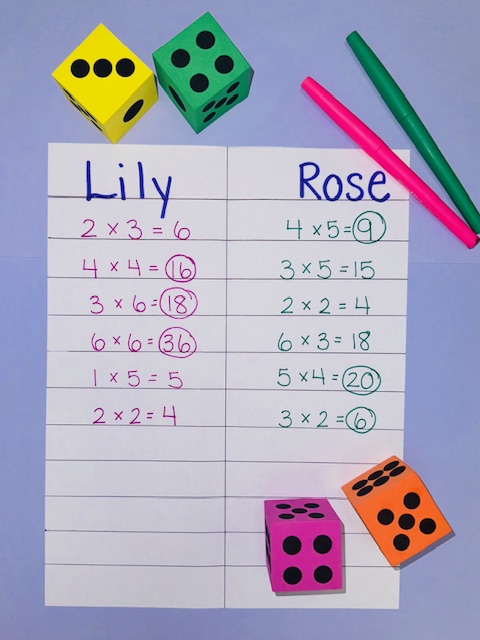
Partner students up. Give each group a pair of dice, lined paper, and a pencil. They should fold the paper in half vertically and write their names at the top of the two columns. Have players take turns rolling the dice and recording the two numbers that come up as factors on the paper in their column. They then multiply these together and write the product. Whoever rolls the highest product in each round wins that round and circles their winning product. You can also play it with the lowest product as the winner. Instead of dice, you can also play this with number cubes marked from 0 to 5 and 6 to 11. You can convert dice to number cubes by putting white sticky dots on each side and writing the numbers you want on them.
Multiplication Museum
Provide a variety of manipulatives like counting chips, cubes, paper clips—almost anything you have plenty of. Also give each student 10 index cards and tell them that they will be setting up their own multiplication museums on their desks using the manipulatives. Each museum should have at least 10 exhibits. An exhibit consists of an arrangement of manipulatives to represent a specific multiplication fact. For example, to show 3 x 7, you might make three cube towers with each one made of seven cubes. Then they fold an index card in half, write the multiplication fact on it, and stand it up as the “exhibit sign.” Finally, have students visit one another’s museums when they are all completed.
Who Am I?
Partner students up and put a deck of multiplication fact cards down in between them. After that, each student takes a turn picking a card. They do not look at the card, but rather hold it against their forehead so their partner can see the card. The partner tells the lead player the product for that fact. For example, if I pick a card that says “3 x 5,” my partner would say, “You’re 15.” Now I have to guess the factors on the card by saying, “I’m 3 x 5.” There are sometimes more than one way to make a product, however. If I said, “I’m 5 x 3,” my partner would say, “No, you’re not. Guess again.” This can really be fun while developing strong mental math and listening skills.
Twister Multiplication
Maybe you have the old classic game Twister at home. If not, check out the thrift shops or online sellers. Take a set of sticky notes, and on each one, write a multiplication fact on one half and the product on the other. Cut them in half. On the Twister spinner, there are color dots. Place the product part of the sticky fact on the spinner dots. On the Twister mat, place the other half of the fact cards on those dots. As you spin, each student will call out the product the spinner points to. Players on the mat have to try to place a hand or foot on the fact that makes that product. Active, fun, and a bit crazy, but it’s a great way to practice multiplication facts.
Multiplication Mix-Up
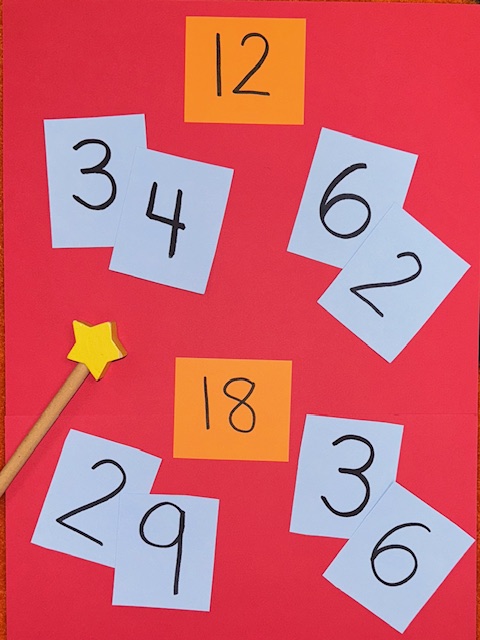
Take index cards and make a set of digit cards 0 to 9 with at least three of each card. Have students shuffle their cards and spread them out on their desks. Call out a product, like 12. Give students three minutes to find pairs of cards that if multiplied together would result in that product. With the product of 12, students should be able to show you the following pairs: 2 x 6, 6 x 2, 3 x 4, and 4 x 3. After a round, ask players to reshuffle and then announce the next product.
Tower of Facts
Use an old Jenga set or pick up a generic one at a dollar store. On each block, use a permanent marker to write a multiplication fact. Then set up a tower. As players pull blocks from the tower, they must answer the multiplication fact on the block. If they are correct, they keep the block, and if they are wrong, all partners get a chance to answer. If all miss, the block gets stacked back up on top. It’s a cooperative game as no one really wants that tower to fall. (Or do they?)
Name Tag Sort
Get a pack of sticky name tags and write multiplication facts you want to practice on each one. Pass out a tag to each student and have them put it on. Begin to call out sorting clues. If a student’s product matches the sort clue, they stand up. If not, they stay seated. Sorting clues include things like “all odd products, all even products, both factors are odd, both factors are even, the product is more than 15, the product is less than 15,” and so on. Let students take turns leading this one.
Multiplication Cup Towers
Buy a set of small disposable plastic bathroom cups. On the side of each one, write a multiplication fact. This is a good activity for a small group of three or four students. Put the set of cups in the middle of the group. Have students take turns pulling a cup. If they answer the fact correctly, they keep the cup and can begin to build a stacking tower. If they miss it, they put the cup back in the middle. Limit play by the number of times you can pull a cup (10 is a good start) or time (two minutes is reasonable).
Lots of Dots
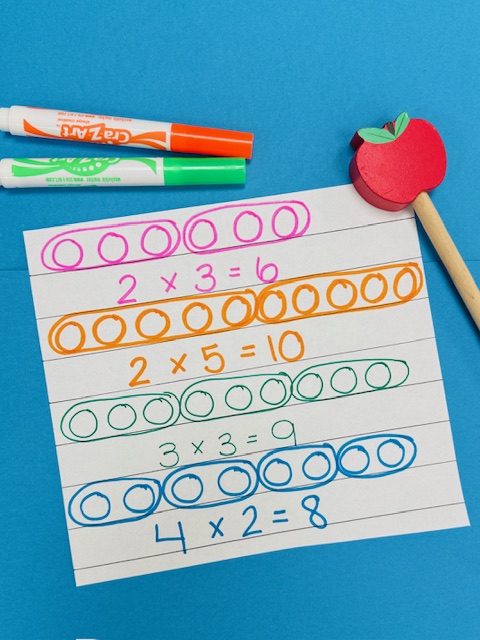
Kids love this simple activity. Give each student a lined paper and a pencil. Tell them to draw a given target number of dots, like 12. After each student does this, ask them to take a crayon and circle the dots in a way that will reveal a multiplication fact. For example, with 12, they might circle two groups of six or six groups of two or three groups of four, and so on. They then write the facts underneath the dots. This calls for careful counting and, of course, knowing some facts!
Domino Multiplication War
Partner up students and give them a set of dominoes. The dominoes should be placed in a box or bag so players can’t see them. Players take turns picking a domino out of the bag. The first player checks both sides of the domino and chooses the side that would yield the largest product when the two dot arrays are multiplied together. They put it face up in the middle. The next player picks a domino and does the same thing. The player with the largest product wins and keeps both dominoes. Play continues until the bag or box is empty. Then players count their dominoes to see who has the most. You can also play this one to try to get the lowest product. Either way is lots of fun.
Bottle Cap Facts
Have students collect bottle caps, wash them, and bring them into class. Distribute the bottle caps evenly among the class. Give students a multiplication fact assessment of the 100 multiplication facts and score them together. Have students circle the facts they missed. Then give them a black fine-point permanent marker and a set of sticky dots. Ask them to write any missed facts on the sticky dots (or facts they found hardest) and attach it to the top of a bottle cap. On the inside of the cap, they write the product.
You can play all kinds of games with bottle caps, but one fun one is to have players trade sets and push a cap to the middle. The player who created that fact set has to answer the fact question. If they’re correct, they get the cap and a point. This allows players to practice facts they found difficult in a game format.
Have a Ball Multiplying Hard Facts
Ask your class what the most difficult multiplication facts to remember are. Write these on the board. Brainstorm strategies to remember them together. Write these strategies next to the hard facts on the board. Then get a soccer ball and write these hard facts on the ball (or balls) with permanent marker. Form a circle and toss the ball to a student. Whatever fact their right thumb lands on is the fact they should answer. Have them refer to the board and the strategies if they are unsure. Take turns tossing the ball around the circle, making sure everyone gets a turn.
Rock, Paper, Multiply!
This game looks like it’s going to be Rock, Paper, Scissors, but it’s not. Partner students up and have them stand and face each other. On the count of three, each player throws out a number of fingers on one hand. Both players look at the fingers, count them, and multiply those two numbers. The first with the correct answer is the winner. As players get more skilled, have them play with two hands each.
Multiplication Clue Cards
Give each student two blank index cards and two multiplication facts. Students should write the two factors down on one side of each card. On the other side, they should write at least three clues that will point other players to what the multiplication fact is. For example, if you give me the fact 3 x 3 = 9, I could write clues like: 1. “Both factors are the same.” 2. “The factors are less than 4.” 3. “The product is odd.” Students take turns reading their clues to the class, while classmates try to guess the fact.
Product Call-Out
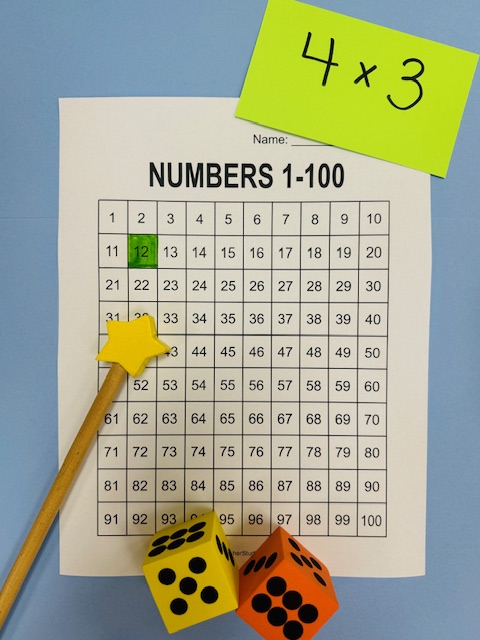
Give each student a copy of a 100 chart and a set of crayons or colored pencils. Then give directions to have students color and locate products for the multiplication fact you call out. For example, when you call out 3 x 5, students should color the number 15 on their charts. This is a great way to emphasize multiplication patterns by calling out all of the facts with a certain factor in a row. For example, you might ask for 3 x 3, 3 x 6, 3 x 2, 3 x 7, and so on. You could call them in order or mix them up a bit like the ones just mentioned. You can use different colors for different fact families if you like.
Multiplication Fact Bingo
Provide each student with a 100 Multiplication Facts Chart. These charts have the factors but not the product. Tell students you will be playing Multiplication Bingo together. You will call out a product, and they must find the fact on their paper and color it in with a light-colored color pencil or crayon so we can still see the facts. When they get three in a row in any direction, they should circle the three and call out, “Bingo!” Write the three facts and products on the board to help everyone check their work. Keep playing on that same sheet and play for as many bingos as you like.
Cover Up
Give each student a blank 15 x 15 array sheet or a sheet of graph paper, pencil, and crayons or colored pencils. Model how you would draw an array for a multiplication fact on a paper like this. For example, if the target fact is 3 x 7, you could draw a rectangle that is three squares across and seven squares down. Outline it in pencil, write the fact and product on the rectangle, and color over it lightly. Explain to students that they should draw and color a rectangular array for each multiplication fact you announce.
The goal for the student is to arrange their arrays to try to cover up as many spaces as possible. After 10 facts are called out, the winner is the person with the least amount of white squares left. Caution students that sometimes they may be unable to make an array that you call because there isn’t enough space left. If that’s the case, they wait until the next fact is called.
Squeeze
Partner students up and give them a set of multiplication fact cards. The lead partner deals out 10 cards to each player. Two cards are then picked at random from the deck and placed on a desk about 2 feet apart. These are the beginning and end cards. Their products signify the beginning and end of a number line. So, if the two cards are 2 x 5 and 6 x 4, the number line stretches from 10 to 24.
Now players fan out their cards with the facts hidden. The lead player picks a card from their partner’s fan and places it on the number line if they can. If you pick an 8 x 6 card, you can’t place it on the number line going from 10 to 24 because the product is 48, so you put it in your deck. Players take turns picking cards and trying to place them. After 10 picks, players count up their cards. The player with the least cards wins.
Multiplication Stories
Give students a lined piece of paper and a pencil, and have them fold it into four squares. Then write four multiplication facts on the board. Ask students to copy the facts at the top of each square. Explain that they should write a short story problem that fits each fact. For example, if I had to write about 5 x 5, I might write something like, “There were five brothers. Each one had five books. How many books did they have all together?” Urge students to be creative. These can get pretty funny. Take turns sharing the problems aloud. Finally, on the back of the paper, have students choose four facts of their own and write stories about those. These are great word problems to use as a source for for tests and quizzes. Give students a “byline” on the paper next to their problem.
(Cl)Arrays
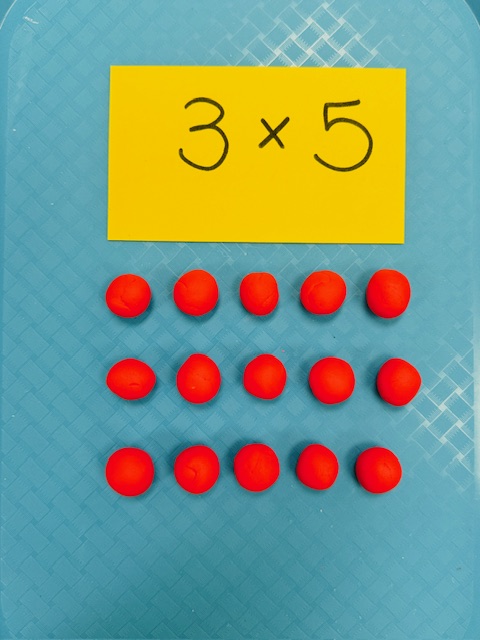
(Cl)Arrays are arrays made out of clay (ha, ha!). Kids love to get their hands on and in clay or play dough so let them go at it while they practice multiplication. Each student gets a good-size ball of clay and a mat to work on. Plastic place mats work well. Write a “Feature Fact” on the board. Each student takes their clay and, making smaller balls, creates an array that matches that fact. Give students a turn to lead and pick the featured fact. You can also feature two or three facts at a time. Emphasize how the first factor tells us how many groups and the second factor tells us how many in a group.
Find That Fact!
Write about 20 multiplication products on the board. Then have two students come up. Explain that you will call out a fact, and players must point to the product that matches your fact as quickly as possible. Whoever points to the fact first wins that round and stays at the board. Keep sending players up until everyone has a turn.
Multiplication Flower Garden
Math and art, they go together. Here’s a decorative way to practice a set of facts. Draw a flower with 12 petals and a circle in the center. Then write the factor for a fact family you want to practice in the center circle, and draw 12 petals and number them 1 to 12. These are the second factors. On the outside of these petals, draw larger petals and write the products of the center and the first petal. Now color. Makes a great math display. Assign different fact families to different students so you can have a complete garden!
Multiplication War
Partner students up and give them a deck of playing cards. Then have the lead player deal out the complete deck face down to each player. Players each flip two of their own cards, multiply them, and say the product aloud. The player with the higher product wins that round and all the cards in the round. Play is complete when all cards have been dealt. Now it’s time to add up the cards to see who wins!
Addition and Multiplication Scramble
Multiplication is really repeated addition but done in a very efficient way. Write a repeated addition sentence on the board, like 5 + 5 + 5 + 5. Ask students to tell you the corresponding multiplication fact with its product. Make sentence strips for each addition sentence and put them in a pile. In another pile, put corresponding multiplication fact cards. Mix these together on the floor in a big pile. Pick a group of four or five students. When you say go, players have two minutes to unscramble and match every addition sentence with its partner multiplication sentence.
Multiplication Concentration
This is a good small-group game for three or four players. Give students a set of index cards and have them write assigned multiplication facts on each card. Now provide another set of index cards and have them write the corresponding products on each card. Have each player put out four matching card sets from their deck. Mix these together and then deal them out face down on a desk. Play a game of Concentration, with each player picking two cards, flipping them over, and seeing how many matches they can find. The most matches wins!
Multiplication Rhymes
Can you write rhymes to go with your multiplication facts? Give each student a set of 10 facts, a lined paper or drawing paper, pencil, and colored pencils or crayons. Provide some examples on the board such as these few from a 3 times table: 3 x 4 = open the door, 3 x 5 = bees in the hive, 3 x 6 = too many sticks, and so on. When completed, have students share their rhymes aloud with the class. You can extend the activity by letting students illustrate their rhymes, which makes for a very creative bulletin board.
Spinner, Spinner, Multiplication Winner
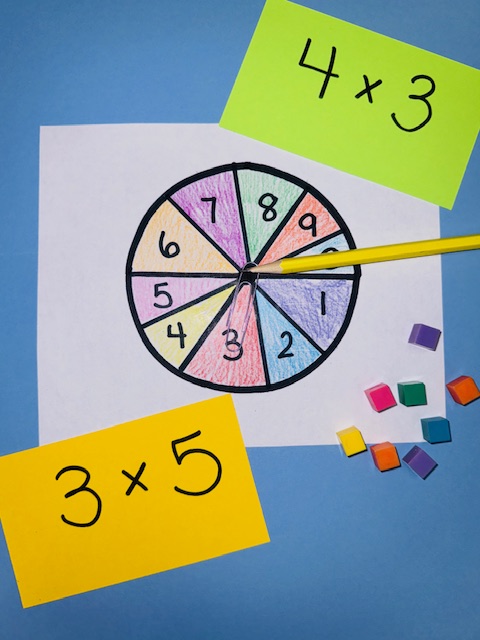
Make a simple spinner with a paper clip and a pencil. Start by having students draw a circle. Tracing around a coffee-can lid is an easy way to do it. Divide the circle up into 10 sections using a ruler. Color the sections and write numbers 0 to 9 on them. Place the paper clip and pencil down in the middle of the circle. Flick the paper clip so it spins. Whatever number it points to is your first factor. Spin again to find the second factor. Multiply them, and that is your score for the round. Your partner does the same. The highest product wins that round. To make it more fun and motivating, put out a set of 20 marbles or cubes. As a player wins a round, they get a cube or marble. Whoever has the most after all are taken is the winner.
Animal Multiplication Stories
You can use animals as the stars of some multiplication stories due to their unique physical characteristics. For example, one story might be, “An octopus has eight legs. Six octopi came to an undersea birthday party. How many legs were there at the party? (8 x 6 = 48 legs).” Let students choose an animal or you can assign one. They should then write a short multiplication story about their animal, solve it, and illustrate it. The picture should match the problem. Consider using horses, cats, dogs, or spiders, and think creatively. For instance, you can count horses’ eyes, ears, legs, tails, and so on.
The Grapes of Math
Read aloud Greg Tang’s math picture book The Grapes of Math (Scholastic, 2004) for some very focused listening and problem-solving with multiplication. Provide each student with a whiteboard and marker. Have students listen to each page and rhyming problem and record on the whiteboard the multiplication fact that matches that page and solves the rhyme. You can do them all in one sitting or spread them out one or two per day. These are all great fun, clever, and sometimes quite challenging.
All Hands on Deck!
Here’s a fun and active way to model some multiplication. Have a group of three students stand in a line at the front of the room. Ask the group to throw out a certain number of fingers. For example, you might say, “Each person please throw out four fingers.” Then ask the rest of the class what multiplication fact they are modeling. In this case it would be 3 x 4 = 12. After that, have various numbers of students come up to form a group and model facts. The rest of the class has to guess the fact aloud or write them on a whiteboard with a marker.
You can also let groups you call huddle up and decide among themselves how many fingers they will throw out when they model their next fact.
Sticky Multiplication Arrays
Kids love stickers, and you can buy inexpensive sets of some really tiny stickers. Give a page of tiny stickers, a pencil, and a piece of graph paper to each student. Then have kids arrange the stickers in arrays on the graph paper, outline them with a pencil, and write matching multiplication facts for each. This is a good activity to assign with an entire fact family, like the sevens for instance. This way students can observe how the facts build incrementally both in number and area.
Multiplication Mistakes
Kids love to correct the teacher. Here’s an activity that gives everyone a chance to do just that. Create a paper where you write 100 multiplication facts with products. Make an error in at least half of them. Make a copy of the paper for each student. Pass these out and explain that this paper was recently handed in to you by your friend Mug the caveman. He is new to math and may have made some mistakes. Ask them to correct the paper by circling the mistakes and writing the correct number next to the error. Student focus on these is incredible!
Number Line Hop
Partner students together and provide them with a number line from 1 to 100, a couple of counting bears or similar game pieces, and a deck of multiplication fact cards. Then players take turns pulling cards from the deck. They solve the fact and move that number of spaces on the number line. First player to the end wins. Players have to pay careful attention as the game progresses because with each round, they have a different starting point. For example, if your first card is 3 x 4, since the product is 12, you hop from 0 to 12. If your second card is 2 x 3, you now start on the 12, move 6 spaces, and land on 18. You can also play this same game on a 100 chart if a number line takes up too much space.
Rubber Stamp Multiplication
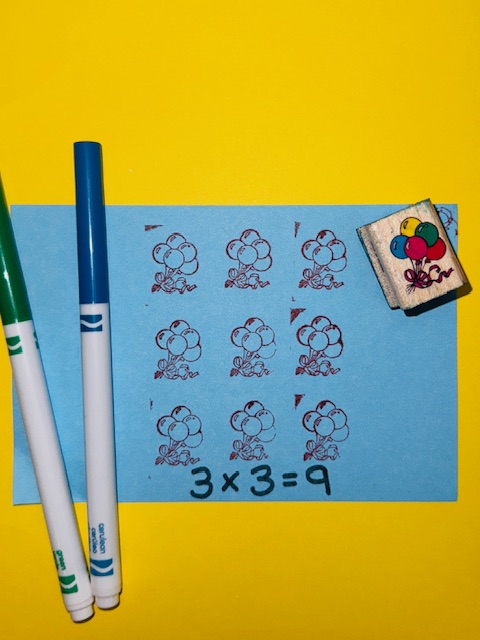
I’ve yet to meet the child who does not like to use a rubber stamp. You can buy almost any kind of rubber stamps, from moons and stars to cats and dogs to flowers and dragons. Get a dozen or so different stamps and some ink pads. Provide students with white drawing or construction paper, an ink pad (can be shared), and a rubber stamp.
Have students stamp out multiplication facts that you decide on for them. This is a good opportunity to work on facts that a student finds difficult. For example, if the target fact is 7 x 8, students would stamp seven rows of eight items in each row. Then they would write the fact and product underneath. Have students take turns trading stamps and ink pads so they can try different images and colors.
Money Multiplier
Make a special spinner that has pictures of the U.S. coins: penny, nickel, dime, quarter, half dollar, and dollar. (You can use a piece of card stock with a coffee-can lid traced on it to form a circle. Divide the circle with a pencil and ruler into six sections, one for each coin, but with the higher-value coins getting smaller sections. For a spinner, use a pencil and a paper clip.
Provide a group of four or five students with a set of play coins. Then put these in the middle of the group along with the spinner. Students take turns spinning and taking one of the coins that the spinner points to. As they play and collect coins, they place like coins in rows in front of them. So, a row of pennies, a row of nickels, a row of dimes, and so on. Give students 10 turns each. Then ask students to write a multiplication fact for each row of coins and the resulting product. They should then add up their products and see what their total coin value is. Highest value wins!
How Old Is the Class?
This intriguing activity combines surveys, data collection, and multiplication to answer an interesting question: “How old is the class?”
Introduce the problem by saying, “I’d like to find out how old this class is. I mean, all together.” Begin by collecting some data. If you are teaching 3rd grade, for example, you can ask students to: “Raise your hand if you are 7.” Then write down that number of students on the board. After that, ask, “Raise your hand if you are 8.” Write down that number of students. And finally ask students to “Raise your hand if you are 9.” Write down that number of students. Say, “Here is the data we need. Now could you all multiply these numbers and then add all the years together? That will tell us how old the class is.”
5 kids x 7 years old = __ years
10 kids x 8 years old = __ years
6 kids x 9 years old = __ years
In this case, 5 x 7 = 35, 10 x 8 = 80, and 6 x 9 = 54. Add them together: 35 + 80 + 54 = 169 years.
You can extend this by sending teams of students out to various classrooms to collect data, do the multiplication and addition, and then find out who has the oldest class in the grade level or in the school.
Kaboom Sticks
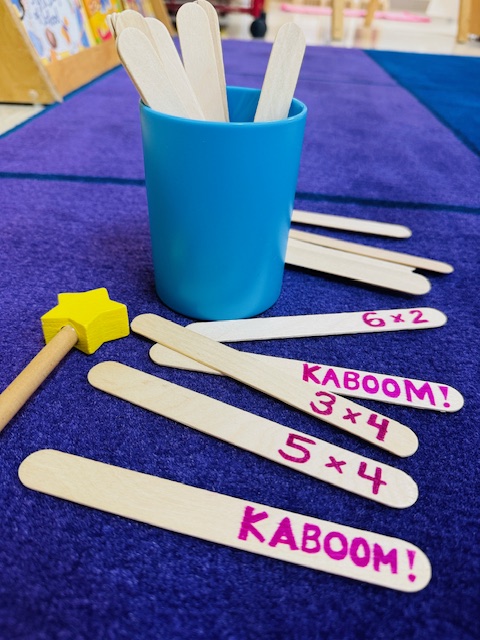
Get a set of wooden craft sticks and write multiplication facts on them, except for a few sticks on which you write “Kaboom!” Then put the sticks with the facts side down in a can. This is a fun activity for a small group. Students take turns pulling sticks from the can. If they get the fact correct, they keep the stick and grow their collection. If they get it wrong, they put it back in the can. And if they pull a “Kaboom” stick, they put their whole collection back in the can.
Triangle Fact Cards
Sometimes just a little change-up can keep things fresh. Students are used to rectangular fact cards, but triangles are a different story. Cut out or have students cut out triangles from oaktag or other durable paper. Then give a set of 10 to each student and assign them a set of facts like ones, twos, threes, and so on. At the top of the triangle, they write the sum, and in the lower corners the two factors. In the middle write a multiplication sign. Color can be added and then cards laminated for long-term use. These sets are somehow more fun to use in games and activities that practice facts.
100-Chart Multiplication Patterns
Make multiple copies of a 100 chart for each student. Also provide crayons or colored pencils, a pencil, and lined paper. Ask students to color in a certain number pattern. For example, you might ask them to color all the numbers that end in 5 or 0 or 8. Then after they have found these, they should write down all the multiplication facts that will result in these numbers as products. Ask them to look for patterns. Have a discussion at the end of each round, and compare what each student has found. There are some intriguing patterns to be discovered!
Room Arrangement Multiplication Hunt
Before students come into the classroom, take certain items and arrange them in groups around the room. For example, set up five stacks of books with four books in each stack, three piles of rulers with eight rulers in each pile, nine index cards with five paper clips on each, three chairs in a circle, and so on.
When students enter, give them each a lined paper on a clipboard and a pencil. Have them sit down and explain that certain items have been gathered in different parts of the room. Their job is to find the items, don’t touch them, but write a description of what they found along with a multiplication fact that matches each arrangement. It’s great fun every time you do this.
Mysterious Multiplication Number Muncher
Ask students to come to the board and write a compete multiplication fact with product. Take turns until you have at least 12 facts on the board. Then ask students to hide their eyes while you erase one number from each problem. Make a monster noise and open and close the door and say, “Open your eyes. The Multiplication Number Muncher was just here and he munched some of the numbers. Who can help us replace them?” Allow students to come up and replace the missing numbers until all are correct. The anticipation is great every time you do this one!
